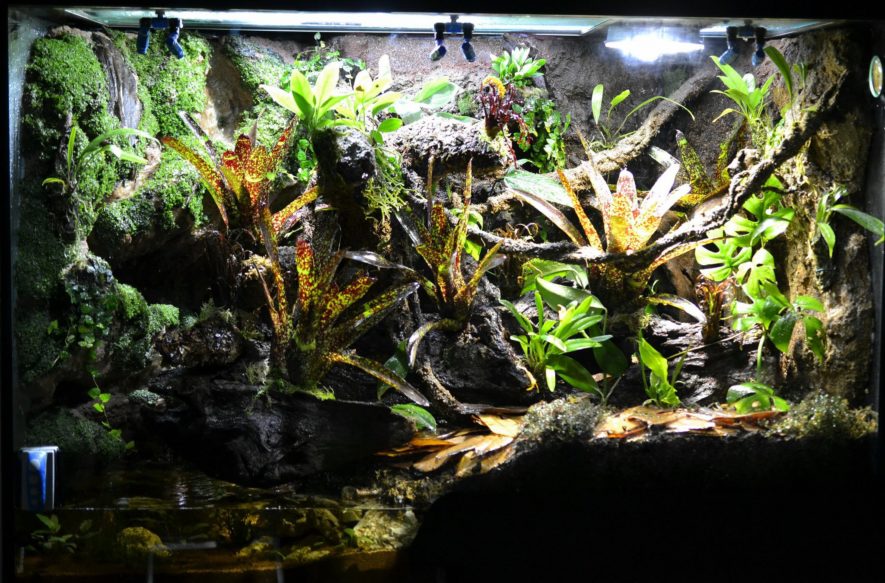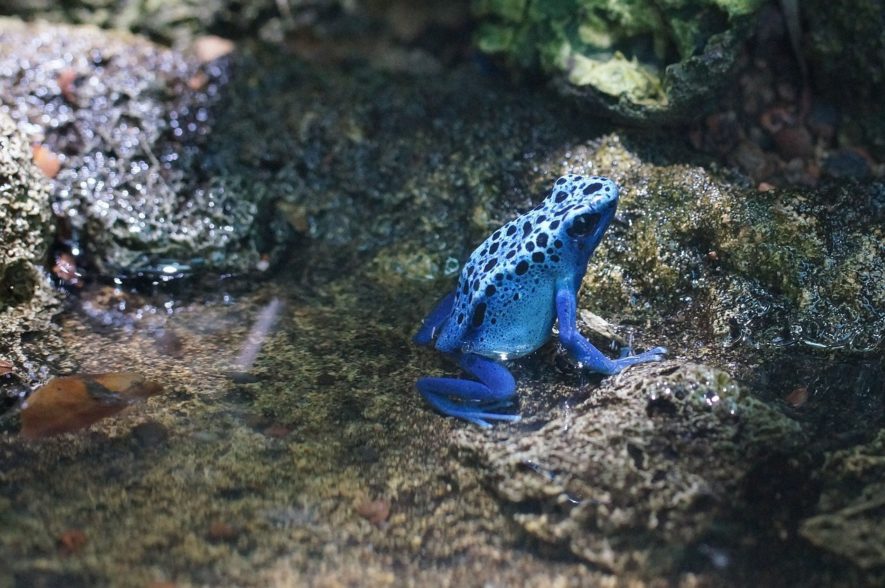Most plants and captive reptiles and amphibians require drinking water, but some also require water for soaking or swimming. Once you’ve decided on the best type of vivarium for your pets, you must start trying to determine the best ways to provide them with the water they require. Additionally, it is important to ensure that the air inside the habitat contains enough moisture.
We’ll discuss each of these needs separately but be aware that they’ll influence each other to some degree. For example, adding a large water reservoir to a habitat will typically raise the humidity level too. Accordingly, you’ll often need to adjust the ways you satisfy these needs and tweak the system routinely.
Drinking Water
Most reptiles suitable for rainforest vivaria should be provided with constant access to clean, fresh drinking water. But you must provide this water in a sensible manner and employ good hygiene practices to prevent your pet from falling ill.
The easiest way to satisfy your pet’s drinking-water needs is by leaving a sturdy, smooth-sided water dish in the habitat at all times. Some keepers are inclined to provide the water for brief periods every few days, but this usually causes more problems than solutions.
Additionally, this is typically done to avoid elevating the humidity level of desert-style terraria. But high humidity levels are typically desirable in rainforest vivaria, so it is wiser to simply leave the bowl in the habitat on a permanent basis.
Ceramic or glass bowls are the best options for reptile and amphibian habitats, as they’re unlikely to spill and they are easy to wash regularly. However, plastic or paper bowls can be used if you’d rather use disposable products.
Because they’re easy to keep clean, round bowls are typically preferred to other shapes. However, they can compromise the natural aesthetic most keepers want from a vivarium. You don’t want to go to great lengths to set up a miniature rainforest, only to ruin it by putting a big ceramic crock in the middle of the floor.
You can use plants, corkbark, branches or other items to hide the water dish and sidestep this problem.
Alternatively, you can opt for a water dish that is designed to look like a log or rock instead. These types of water dishes will, however, require more effort to keep clean, as they usually have small nooks and crannies that can harbor bacteria and algae.

Note that some animals prefer to obtain drinking water from dew or rain instead of a container of standing water. Green tree pythons and emerald tree boas, for example, will usually drink from water dishes, but they typically prefer to drink rain droplets directly from their bodies. Anoles and chameleons, on the other hand, usually ignore standing water entirely.
You’ll need to mist the habitat daily or install a drip system when keeping these types of animals. You can use a small, hand-powered spray bottle to mist a 10- or 20-gallon habitat, but a larger, pressurized sprayer is preferable for large vivaria. Automated misting systems can even be installed if you are willing to go to the trouble and expense of setting one up.
It will take some practice to learn how much water your pet requires, so watch closely to see when drinking behavior ceases.
Always ensure that the water you use for misting is held to the same standards as the water you’d use to fill a water dish. Spring water or purified water is often ideal, although dechlorinated tap water is typically safe for reptiles. Always be sure to use room-temperature water to avoid shocking your pet.
Soaking and Swimming Solutions: Water Reservoirs
In addition to drinking water, many commonly kept herps will also require a reservoir that permits them to soak or swim. For that matter, most amphibians satisfy their water requirements entirely through direct contact with water. They don’t drink water at all. Instead, they sit in a dish of water (or a damp area in the habitat) and absorb the water directly.
A water dish or container will provide small reptiles and amphibians with the opportunity to soak, and perhaps to swim. But larger pets will require a pool of significant size.
The easiest way to do so is by filling the bottom of the habitat with gravel, and then hollowing out a depression to serve as the water reservoir.
Once you’ve shaped the water reservoir and surrounding banks, you can flood the bottom portion of the habitat. Water will flow into the spaces in the gravel, but it will also fill the depression and create the pool. Then, you can add substrate on top of the gravel.
This is a common technique that often works well and looks great. However, it does present a few challenges. For example, you’ll need to add a significant quantity of gravel to the habitat to make such a reservoir, which will raise the habitat’s weight considerably.
Filtration
You’ll need to install a very high-quality filtration system to keep this type of water reservoir clean. Minimally, this will require a three-step filter and a pump suitable for moving the quantity of water in question.
A three-step filter works by cleaning the water in three different ways to address three different types of pollutants.
- The first step is usually mechanical filtration, which seeks to remove particulate matter from the enclosure. This is typically accomplished by forcing the water through some type of filter media that acts as a sieve. A fine screen may also be placed over the inlet to prevent animals and large items from entering the filter.
- The second stage of filtration is called biological filtration. To accomplish this, beneficial bacteria are cultivated on some type of matrix-like structure, where they metabolize undesirable compounds in the water, such as ammonia. Typically, these bacteria colonize the filter naturally with use, but you’ll need to follow the manufacturer’s instructions to ensure you don’t kill off the bacteria during water changes and filter cleanings.
- Chemical treatment is usually the third stage in the filtration process. During this phase of the water treatment, the water is passed over activated carbon. The carbon bonds with many potentially harmful chemicals, rendering the problematic compounds inert and the water safer.

It is much more difficult to filter the water in a vivarium than it is the water in an aquarium. The water in a reptile or amphibian habitat generally holds far more particulate matter than an aquarium does. This can bog-down underpowered filters, leaving your pet’s water dirty.
To ensure that the filter and pump can handle the task, select those that are rated for two to three times the volume of the water reservoir. In other words, if your habitat holds about 10 gallons of water, select a filter rated for 20- or 30-gallon aquaria.
But this does not mean you should use the strongest filter you can find. Filters that produce strong water currents can endanger your pets.
Usually, it is preferable to keep the filter outside of the enclosure. Flexible tubes can then be used to transport the water to and from the enclosure. This will facilitate maintenance and make it easier to troubleshoot problems. However, clever keepers can often devise ways to hide a small filtration unit inside well-planted vivaria.
It is also important to “flush” the gravel beneath the substrate regularly. This will push the bacteria and debris trapped in the gravel into the reservoir, where it can be treated by the filter. You can do so by gently pouring water on top of the substrate so that it can trickle down into the gravel.
A turkey baster is an excellent tool for flushing small habitats, but large cages will require you to use a bottle of water or hose with a shut-off valve.
Relative Humidity
Relative humidity is another important consideration for vivaria maintenance. Proper humidity levels will help to keep your pets healthy, adequately hydrated and encourage full, problem-free sheds. Sufficient air moisture will also help keep the plants healthy too.
Because most homes are much drier than rainforests, it is usually necessary to increase the humidity level of rainforest vivaria. There are a number of ways to accomplish this tactically, but they all fall under one of two strategic options. You can either add more water to the habitat or reduce the amount of water leaving the habitat. This occurs when water-laden air in the habitat flows into the surrounding room.
How to Control the Humidity?
We’ll discuss ventilation in a later article. For now, let’s concentrate on methods by which you can increase the amount of water you add to the habitat. The three most effective ways to do so include:
- Frequently misting the habitat. Misting is one of the best ways to increase the humidity of a habitat. It coats most of the surfaces in a thin layer of water, which will quickly evaporate into the air. It will typically be necessary to mist the habitat daily to raise the humidity to adequate levels. As when you are misting the habitat to provide drinking water, it is important to use water that is clean enough for your animal to drink.
- Increasing the size of the water reservoir. The more water that is in contact with the air in the habitat, the more water the air will absorb. This means that a large water container will help raise the humidity in the enclosure. However, you don’t need the container to be very deep. It is the water’s surface area that is the most important factor. Accordingly, a wide, shallow water reservoir is best. Note that the water level will drop over time as water evaporates, so you’ll need to routinely add water.
- Adding water to the substrate. Some substrates – including shredded coconut products, mulches and soil – will absorb water and slowly release it into the air. So, you can simply pour a small amount of water into the substrate and mix it around. The humidity will climb over time. Don’t saturate the substrate when doing so, as this can lead to unsanitary conditions; just dampen it slightly. Obviously, you’ll have to add more water regularly to compensate for that which is lost through air exchange.

But it isn’t simply good enough to raise the humidity in the habitat. You must raise it to an appropriate range. Some animals – particularly those who dwell on the damp rainforest floor or forests at high altitude, which are almost always soaked – require very high humidity levels that approach the saturation point.
Others, however, will not thrive in these conditions and require more moderate humidity levels. As the keeper, you must investigate the specific needs of your animal and strive to maintain the appropriate levels.
You’ll need to use a humidity-measuring tool to do so. It’s also important to watch your animal closely for signs of dehydration or dry skin.
It is often wise to allow the habitat to go through a daily humidity cycle. The amount of moisture in the air will rise to its highest levels shortly after you add water each morning. It should slowly fall through the afternoon and night. By the next morning, there shouldn’t be any water droplets coating the glass or plants. If standing water persists, reduce the amount of water you add to the habitat each morning.
What is your favorite method to control humidity in your vivarium? And don’t forget, if you found this article helpful, go ahead and share it with your reptile- and amphibian-keeping friends.

